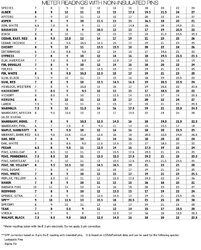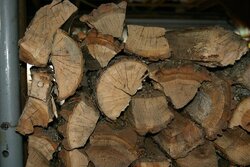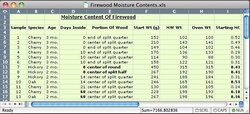So... I went out to the wood piles, took some pieces and started splitting and taking moisture readings (Harbor Freight meter). I must say, it was an education. It may change the order and manner in which I burn my wood. Bear in mind, I bought my stove last fall and started harvesting wood in summer of 09. I have to burn what I have, but at least I can guarantee it will be drier than what I burned last year (still saved $800 on my heating bills).
So here's what I found:
Red Oak (split and stacked July 09): MC mostly in upper teens. A few isolated spots as high as 22 or 23% (Some of these were very fat splits too)
Sugar maple (split and stacked November 09): MC Mostly mid to upper teens, one or two spots as high as 21 or 22%
Hackberry and Soft Maple (purchased and stacked March 2010): MC Consistently in mid teens (This stuff was not seasoned and was wet with snow when I got it.)
Black Locust (split and stacked Aug-Sept 09): MC from upper teens up to mid 20s ! (Considering its low initial MC, I was surprised. Split pieces stayed within 22, but rounds much higher.
Osage (split and stacked Aug-Sept 09): MC from upper teens up to 22%
Honey Locust (split and stacked Sept 09): MC ranging from mid teens to mid 20s (this stuff had been bucked since May! Some pieces were good and dry; others not nearly dry enough)
I also had a bit of cherry and mulberry, but I haven't tested any of these yet.
I was pleasantly surprised by the levels on the oak and maple. Very pleased with the hackberry and soft maple considering it was actually in the shade of my house.
One question: How do you figure the MC of a given piece of wood? Do you go by the worst (wettest) spot on the split or do you average that with the 75% that is in the mid to upper teens? If you go by the average, I would say almost every piece was at or below 20%, but if you go by the worst part, I've got a lot of marginal pieces.
I tried to take my moisture readings from parts of the split that are furthest from an outer edge. Seems they are always most moist near bark.
Further information:
I stored most of this wood in an open, fairly sunny area with a good amount of wind exposure. I also keep a tarp over the tops of my racks during non summer months and hang some plastic during the winter to prevent rain and snow infiltration.
So here's what I found:
Red Oak (split and stacked July 09): MC mostly in upper teens. A few isolated spots as high as 22 or 23% (Some of these were very fat splits too)
Sugar maple (split and stacked November 09): MC Mostly mid to upper teens, one or two spots as high as 21 or 22%
Hackberry and Soft Maple (purchased and stacked March 2010): MC Consistently in mid teens (This stuff was not seasoned and was wet with snow when I got it.)
Black Locust (split and stacked Aug-Sept 09): MC from upper teens up to mid 20s ! (Considering its low initial MC, I was surprised. Split pieces stayed within 22, but rounds much higher.
Osage (split and stacked Aug-Sept 09): MC from upper teens up to 22%
Honey Locust (split and stacked Sept 09): MC ranging from mid teens to mid 20s (this stuff had been bucked since May! Some pieces were good and dry; others not nearly dry enough)
I also had a bit of cherry and mulberry, but I haven't tested any of these yet.
I was pleasantly surprised by the levels on the oak and maple. Very pleased with the hackberry and soft maple considering it was actually in the shade of my house.
One question: How do you figure the MC of a given piece of wood? Do you go by the worst (wettest) spot on the split or do you average that with the 75% that is in the mid to upper teens? If you go by the average, I would say almost every piece was at or below 20%, but if you go by the worst part, I've got a lot of marginal pieces.
I tried to take my moisture readings from parts of the split that are furthest from an outer edge. Seems they are always most moist near bark.
Further information:
I stored most of this wood in an open, fairly sunny area with a good amount of wind exposure. I also keep a tarp over the tops of my racks during non summer months and hang some plastic during the winter to prevent rain and snow infiltration.





